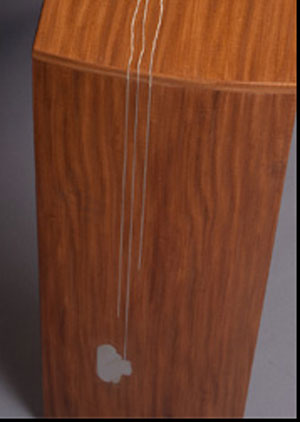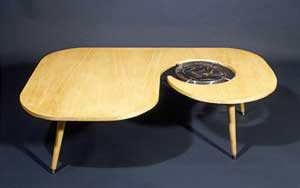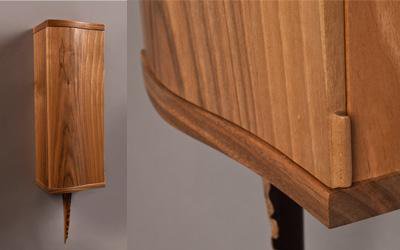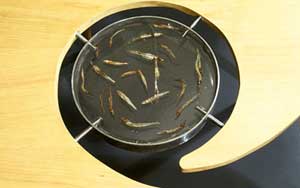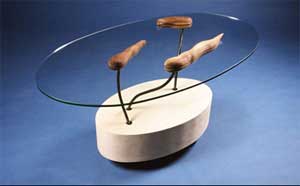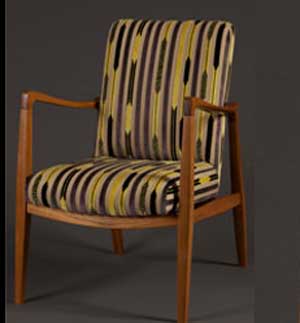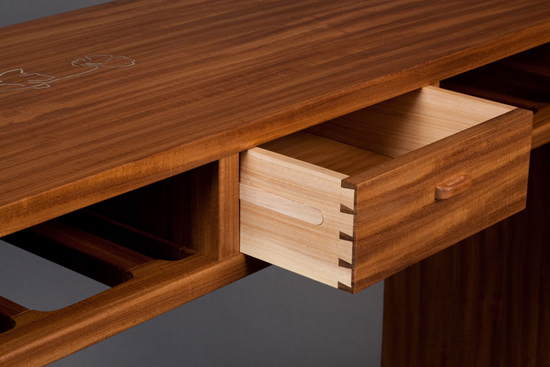
The experience that “solidified in my mind that I wanted to go into woodworking” for Meredith Nicole was a tale she heard in France. Living in England at the time, Meredith had hopped across the channel for a French visit and was sitting at the dining table in a French farmhouse, where she heard about the family’s — and the table’s — history during World War II. Occupying Germans had removed all of the family’s heirloom furniture from the farmhouse and burned it in front of them — except the dining room table, which was too massive to move. “And, of course, it was that table I was sitting at,” Meredith said.
The experience intensified her desire to “participate in making heirloom furniture” — and also inspired her own piece, “Tank Table,” which includes a decorative element of a World War II tank, and has words like “love” and “integrity” inscribed into it.
She was always drawn to furniture making, Meredith says, but started out thinking that she would become a designer. Not having been exposed to a lot of woodworking while growing up, “The link between woodworking and furniture making didn’t exist in my mind,” she said.
After going to art school in her early 20s, where she kept making furniture — from wood, metal, synthetics, etc. — in her art classes, Meredith moved from Canada to Taiwan. Partly it was to pay off her student loan, partly to have her designs made and “see how it went.” She discovered that “coming up with designs excited me, but I didn’t like working with factories.”
From there, Meredith moved to England, where she lucky enough to fall in with the owner of an antiques shop who allowed her access to a woodshop and sent her to auctions where she found various old pieces that she would take apart and learn by doing how to put them back together so they were sound. “It taught me about the structural integrity of furniture when it was made,” she said.
Under the impression that she would need to find a European apprenticeship to pursue the kind of woodworking furniture making career that her France experience had inspired, Meredith took what was meant to be a brief trip home to Canada to visit family — and discovered a school that was “exactly what I needed.”
The Inside Passage of School of Fine Woodworking in Roberts Creek, British Columbia, is an intimate school with aesthetics inspired by College of the Redwoods founder James Krenov, a friend of Inside Passage founder Robert Van Norman. “We learned how to build our own tools: wooden planes, even wooden hardware if we had a piece that was complicated and we needed a specialized hinge,” Meredith said. James Krenov offered weekly lectures at the school until his death in 2009, and his ideas about the harmony of wood grain and creating unity in a piece were influential.
Meredith describes her own style, however, as having more of an artistic approach. “I definitely see myself as an artist as well as a furnituremaker,” she said. “The formal side of furniture is what attracted me in the beginning, and I like the functionality of furniture, but I have a more creative, contemporary style. There’s always something quirky about it, some decorative element thrown in there.”
Currently, she’s experimenting with the gun barrel technique for decorative items: making a groove in a piece without removing any wood, tapping a thin piece of silver into it, then dampening the wood so that the groove swells back up and traps the silver, without the need for any adhesives.
The first furniture piece she made, before her training, she calls an “introduction to exploring creativity and furniture and playing.” It’s a table into which she inserted a resin mold filled with dried anchovies, suspended in a circle inside the table. “As you approach the table, it has a clean look, but when light passed through it, the suspended anchovies would create shadows on the floor.”
Tables and chairs are still Meredith’s favorite pieces to make. “I just love tables. It’s one of the most intimate pieces of furniture: you eat off of it, you can sit down on the floor and doodle on it; there’s just something about tables that I really enjoy.”
As for chairs, since all of her chair designs incorporate textiles, and Meredith doesn’t do the textile work herself, the appeal there is the opportunity to collaborate with designers. “I like collaborating.”
In particular, she’s enjoyed a couple of opportunities to collaborate with clients who have had trees come down on their property. “It’s an exciting process to take something that’s been on a property someone’s whole life and make something out of it,” Meredith said. So far, in this part of her business, she has worked with clients with downed trees of cherry and arbutus [known as madrone in the U.S.], which Meredith describes as “illegal to log, but beautiful.”
In general, Meredith likes hardwoods, and oily woods. “I’m definitely attracted to exotic hardwoods,” she said. Having recently had the opportunity work with teak, she notes that “I’m pretty in love with it” for its working properties and the way the color tones look as they move through the wood — although she’s’ concerned about a lack of sustainable harvesting methods. “Whenever I use a wood, I like to give a donation from a percentage of the sale to an organization involved with preserving the species,” she said.
“I also want to look at how to create awareness of these woods, what it means to use them, where they come from, how they’re harvested.” The research experience of using a new wood is also part of the appeal for her: “I get really excited about a new wood: what do the flowers look, what do the locals use it for…there’s a learning side to it that I really enjoy.”
The education portion for buyers of furniture pieces is what Meredith thinks is lacking in her current location in Vancouver, and it’s why one of her business goals is to open a gallery within the next five years. “Our only wood co-op closed last year, and for high-end, well-constructed pieces, there’s not a lot of venues,” she said. “The closest is Seattle, three hours away.” In Vancouver, “A couple of galleries occasionally put in furniture pieces, but it’s not really what their focus is. It’s seen more as an art object, and if people are going to think about spending $5,000 on a table, they need a little bit more information about why it’s that price.”
